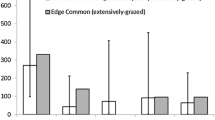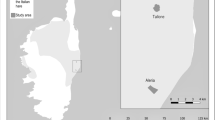Abstract
South Georgia has many introduced plant and animal species, a consequence of its long history of human habitation. Introduced reindeer have a strong effect on the vegetation of the Stromness Bay area by causing the replacement of indigenous species by grazing-tolerant grasses such as the exotic Poa annua, and in certain circumstances, the indigenous Festuca contracta. Recently it has been argued that an introduced predatory carabid has contributed to declines in the abundance and an increase in the body size of adults of the indigenous perimylopid beetle Hydromedion sparsutum. However, it also appears that body size of these beetles is smaller in areas where exotic grasses predominate compared to undisturbed areas. Here we test the hypothesis that by causing the spread of poorer quality grasses, especially the exotic Poa annua, reindeer may be having an indirect effect on H. sparsutum. To do this we examined the nutritional ecology of H. sparsutum larvae on four grass species which form a major part of its diet, viz. the indigenous Parodiochloa flabellata, Phleum alpinum and Festuca contracta, and the exotic Poa annua. Larvae showed the highest growth rate on Parodiochloa flabellata, followed by Phleum alpinum, F. contracta and Poa annua. These differences are due to poorer absorption of the exotic grass, and poorer utilization of the absorbed material in the case of F. contracta. Poor growth of larvae on F. contracta appears to be due to its low water and nitrogen contents, whereas in the case of P. annua a combination of low water content and high nitrogen content may be responsible for low growth rates. Low growth rates associated with poor-quality food may lead either to a prolongation of the life cycle or of the length of feeding bouts of an insect. Neither option appears to be feasible for H. sparsutum, and this means that the outcome of feeding on poorer-quality foods would be a reduction in final adult size. This has fitness consequences for the beetle. Hence it appears that by causing the spread of grasses that are unsuitable for growth of H. sparsutum, reindeer may be having an indirect effect on this beetle species.
Similar content being viewed by others
Author information
Authors and Affiliations
Additional information
Received: 18 August 1996 / Accepted: 7 February 1997
Rights and permissions
About this article
Cite this article
Chown, S., Block, W. Comparative nutritional ecology of grass-feeding in a sub-Antarctic beetle: the impact of introduced species on Hydromedion sparsutum from South Georgia. Oecologia 111, 216–224 (1997). https://doi.org/10.1007/s004420050228
Issue Date:
DOI: https://doi.org/10.1007/s004420050228




